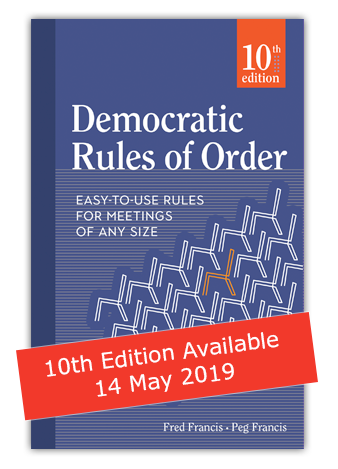| Democratic Rules of Order |
Robert’s Rules of Order |
| 27 pages of rules plus 37 pages of answers to questions, examples, etc. |
Up to 700 pages of rules and protocol (depending on which edition) |
| All motions have similar properties so there are no complicated classifications to learn |
There are many kinds of motions: main, subsidiary, incidental, privileged, and they all have special properties which must be learned or found in tables.
- Some are debateable, some aren’t.
- Some can be amended, some can’t.
- Some require a majority to pass, some more.
- Some need seconding, some don’t, etc.
|
| Uses plain language so no need to learn a specialized vocabulary. |
Contains some special phrases which must be learned e.g.: “the previous question”, “orders of the day”, “lay on the table”, “question of privilege”, “suppress debate”, etc. |
| Allows informal decision-making but automatically requires more formality when necessary. |
Rather formal when it’s rules are consistently followed. |
| Members with a greater knowledge of the rules have no special advantage. |
Members with a greater knowledge of the rules can use it for personal advantage. |
| Originally written in 1994 as rules of order for meetings of any size. |
Originally written in 1876 based on rules of order for the United States Congress. |
| Contains rules for every likely situation. |
Contains rules for every likely situation. |
| Likely to be read and understood by the Chair and many members. |
Likely to be partially read and understood by the Chair and a few members. |



